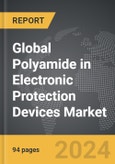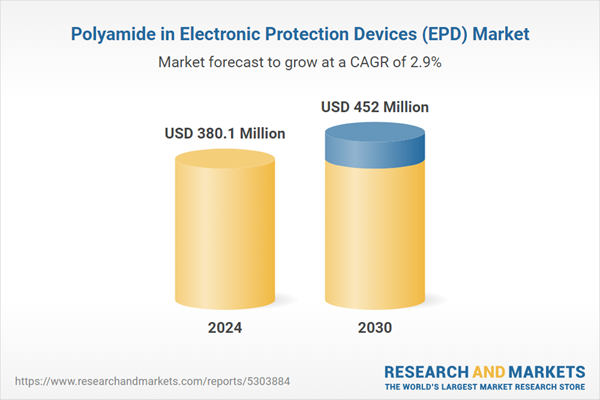The global market for Polyamide in Electronic Protection Devices (EPD) was valued at US$380.1 Million in 2024 and is projected to reach US$452.0 Million by 2030, growing at a CAGR of 2.9% from 2024 to 2030. This comprehensive report provides an in-depth analysis of market trends, drivers, and forecasts, helping you make informed business decisions. The report includes the most recent global tariff developments and how they impact the Polyamide in Electronic Protection Devices (EPD) market.
Segments: Product Type (PA 6, PA 66, PA 4,6, Other Product Types); Device (MCB, MCCB, Relays, Other Devices).
Geographic Regions/Countries: World; United States; Canada; Japan; China; Europe (France; Germany; Italy; United Kingdom; Spain; Russia; and Rest of Europe); Asia-Pacific (Australia; India; South Korea; and Rest of Asia-Pacific); Latin America (Argentina; Brazil; Mexico; and Rest of Latin America); Middle East (Iran; Israel; Saudi Arabia; United Arab Emirates; and Rest of Middle East); and Africa.
The analysts continuously track trade developments worldwide, drawing insights from leading global economists and over 200 industry and policy institutions, including think tanks, trade organizations, and national economic advisory bodies. This intelligence is integrated into forecasting models to provide timely, data-driven analysis of emerging risks and opportunities.
Global Polyamide in Electronic Protection Devices (EPD) Market - Key Trends & Drivers Summarized
What Role Does Polyamide Play in Electronic Protection Devices?
Polyamide, commonly known as nylon, plays a vital role in the manufacturing of Electronic Protection Devices (EPDs), which are critical components used to safeguard electronic circuits from overload, short circuits, and other potential hazards. EPDs, including circuit breakers, fuses, and surge protectors, require materials with excellent mechanical and thermal properties, as they need to withstand high temperatures and mechanical stress while ensuring electrical insulation. Polyamide, with its superior thermal stability, high electrical resistance, and mechanical durability, has become one of the most preferred materials for housing and insulating electronic protection devices. It also offers excellent resistance to chemicals, moisture, and wear, making it ideal for use in harsh environments, where electronic protection is critical. The material’s flexibility allows for the production of complex shapes, which is particularly beneficial in designing compact and high-performance EPDs. As the electronics industry continues to evolve, the demand for advanced materials like polyamide is expected to grow, given its ability to meet the rigorous safety and performance standards required by modern electronic devices.How Are Industry Demands and Technological Advancements Influencing Polyamide Use in EPDs?
The increasing demand for miniaturized and high-performance electronic devices has significantly impacted the development and use of polyamide in EPDs. As electronic systems become more compact and powerful, the need for protection devices that can offer efficient performance within smaller spaces has grown. Polyamide's ability to be molded into intricate and compact designs makes it an ideal material for these applications. Additionally, the shift towards smart electronics and the integration of more sophisticated electronic systems in industries such as automotive, aerospace, telecommunications, and consumer electronics have raised the bar for EPD performance. These industries require EPDs that can operate under extreme conditions, such as high temperatures and mechanical stress, where polyamide’s thermal and mechanical properties prove invaluable. Technological advancements in polyamide materials, such as the development of flame-retardant and reinforced polyamides, have further enhanced the safety and functionality of EPDs. Flame-retardant polyamides are particularly important in electrical applications, reducing the risk of fire hazards while maintaining structural integrity under thermal stress. Reinforced polyamides, which incorporate glass fibers or other fillers, offer improved stiffness and strength, extending the lifespan of electronic protection devices even in demanding applications.How Does Polyamide Enhance the Durability and Performance of EPDs in Critical Industries?
In industries where reliability and safety are paramount, such as automotive, industrial machinery, and telecommunications, polyamide plays a crucial role in ensuring that EPDs perform optimally under challenging conditions. For instance, in the automotive sector, polyamide is used in various protection devices that safeguard electrical systems in both conventional and electric vehicles. Given its excellent resistance to chemicals, oil, and high temperatures, polyamide is ideal for automotive applications where components are exposed to harsh environmental conditions. In industrial settings, polyamide ensures that EPDs can endure prolonged exposure to high temperatures, vibration, and mechanical stress, maintaining the integrity of critical electrical systems. In telecommunications, where devices must function in both indoor and outdoor environments, polyamide offers protection against moisture, UV radiation, and extreme temperatures, ensuring the longevity and reliability of surge protectors, circuit breakers, and other EPDs. Additionally, the lightweight nature of polyamide reduces the overall weight of these devices, which is beneficial for sectors such as aerospace, where weight savings are crucial for improving efficiency and performance.What Factors Are Driving the Growth of Polyamide in the EPD Market?
The growth in the polyamide in Electronic Protection Devices (EPD) market is driven by several factors, closely aligned with the technological evolution of the electronics industry, growing demand for safety and efficiency, and environmental sustainability. One of the primary growth drivers is the increasing use of advanced electronics in industries such as automotive, industrial automation, and consumer electronics, which demand high-performance protection devices to safeguard sensitive circuits and systems. As these industries continue to expand, the need for durable, heat-resistant, and reliable materials like polyamide becomes critical. The rise of electric vehicles (EVs) and renewable energy systems is also driving demand for advanced EPDs, where polyamide is essential for creating durable housings and components capable of withstanding high voltages and extreme environmental conditions. Additionally, the trend toward miniaturization of electronic devices requires materials that can maintain structural integrity and performance in compact designs, further fueling the adoption of polyamide. Environmental regulations and consumer preferences for flame-retardant, recyclable, and eco-friendly materials are also pushing manufacturers to adopt innovative polyamide solutions, particularly those with flame-retardant properties. Lastly, advancements in material science, such as reinforced and modified polyamides, are enabling the development of more robust, efficient, and cost-effective EPDs, contributing to the growth of the market. These trends reflect the growing importance of polyamide in the EPD industry as electronic devices become more sophisticated, efficient, and safe.Report Scope
The report analyzes the Polyamide in Electronic Protection Devices (EPD) market, presented in terms of units. The analysis covers the key segments and geographic regions outlined below.Segments: Product Type (PA 6, PA 66, PA 4,6, Other Product Types); Device (MCB, MCCB, Relays, Other Devices).
Geographic Regions/Countries: World; United States; Canada; Japan; China; Europe (France; Germany; Italy; United Kingdom; Spain; Russia; and Rest of Europe); Asia-Pacific (Australia; India; South Korea; and Rest of Asia-Pacific); Latin America (Argentina; Brazil; Mexico; and Rest of Latin America); Middle East (Iran; Israel; Saudi Arabia; United Arab Emirates; and Rest of Middle East); and Africa.
Key Insights:
- Market Growth: Understand the significant growth trajectory of the PA 6 segment, which is expected to reach US$190.1 Million by 2030 with a CAGR of a 3.1%. The PA 66 segment is also set to grow at 3.3% CAGR over the analysis period.
- Regional Analysis: Gain insights into the U.S. market, valued at $102.1 Million in 2024, and China, forecasted to grow at an impressive 4.1% CAGR to reach $86.1 Million by 2030. Discover growth trends in other key regions, including Japan, Canada, Germany, and the Asia-Pacific.
Why You Should Buy This Report:
- Detailed Market Analysis: Access a thorough analysis of the Global Polyamide in Electronic Protection Devices (EPD) Market, covering all major geographic regions and market segments.
- Competitive Insights: Get an overview of the competitive landscape, including the market presence of major players across different geographies.
- Future Trends and Drivers: Understand the key trends and drivers shaping the future of the Global Polyamide in Electronic Protection Devices (EPD) Market.
- Actionable Insights: Benefit from actionable insights that can help you identify new revenue opportunities and make strategic business decisions.
Key Questions Answered:
- How is the Global Polyamide in Electronic Protection Devices (EPD) Market expected to evolve by 2030?
- What are the main drivers and restraints affecting the market?
- Which market segments will grow the most over the forecast period?
- How will market shares for different regions and segments change by 2030?
- Who are the leading players in the market, and what are their prospects?
Report Features:
- Comprehensive Market Data: Independent analysis of annual sales and market forecasts in US$ Million from 2024 to 2030.
- In-Depth Regional Analysis: Detailed insights into key markets, including the U.S., China, Japan, Canada, Europe, Asia-Pacific, Latin America, Middle East, and Africa.
- Company Profiles: Coverage of players such as AdvanSix, Inc., Ascend Performance Materials LLC, BASF SE, Dow, Inc., DuPont de Nemours, Inc. and more.
- Complimentary Updates: Receive free report updates for one year to keep you informed of the latest market developments.
Some of the 43 companies featured in this Polyamide in Electronic Protection Devices (EPD) market report include:
- AdvanSix, Inc.
- Ascend Performance Materials LLC
- BASF SE
- Dow, Inc.
- DuPont de Nemours, Inc.
- EMS Chemie Holding AG
- Goodfellow, Inc.
- Huntsman Corporation
- INVISTA S.A.R.L
- Lanxess AG
- Nilit Ltd.
- Royal DSM
- Toray Industries, Inc.
- Ube Industries, Ltd.
Tariff Impact Analysis: Key Insights for 2025
Global tariff negotiations across 180+ countries are reshaping supply chains, costs, and competitiveness. This report reflects the latest developments as of April 2025 and incorporates forward-looking insights into the market outlook.The analysts continuously track trade developments worldwide, drawing insights from leading global economists and over 200 industry and policy institutions, including think tanks, trade organizations, and national economic advisory bodies. This intelligence is integrated into forecasting models to provide timely, data-driven analysis of emerging risks and opportunities.
What’s Included in This Edition:
- Tariff-adjusted market forecasts by region and segment
- Analysis of cost and supply chain implications by sourcing and trade exposure
- Strategic insights into geographic shifts
Buyers receive a free July 2025 update with:
- Finalized tariff impacts and new trade agreement effects
- Updated projections reflecting global sourcing and cost shifts
- Expanded country-specific coverage across the industry
Table of Contents
I. METHODOLOGYII. EXECUTIVE SUMMARY2. FOCUS ON SELECT PLAYERSIII. MARKET ANALYSISCANADAITALYSPAINRUSSIAREST OF EUROPESOUTH KOREAREST OF ASIA-PACIFICARGENTINABRAZILMEXICOREST OF LATIN AMERICAIRANISRAELSAUDI ARABIAUNITED ARAB EMIRATESREST OF MIDDLE EASTIV. COMPETITION
1. MARKET OVERVIEW
3. MARKET TRENDS & DRIVERS
4. GLOBAL MARKET PERSPECTIVE
UNITED STATES
JAPAN
CHINA
EUROPE
FRANCE
GERMANY
UNITED KINGDOM
ASIA-PACIFIC
AUSTRALIA
INDIA
LATIN AMERICA
MIDDLE EAST
AFRICA
Companies Mentioned (Partial List)
A selection of companies mentioned in this report includes, but is not limited to:
- AdvanSix, Inc.
- Ascend Performance Materials LLC
- BASF SE
- Dow, Inc.
- DuPont de Nemours, Inc.
- EMS Chemie Holding AG
- Goodfellow, Inc.
- Huntsman Corporation
- INVISTA S.A.R.L
- Lanxess AG
- Nilit Ltd.
- Royal DSM
- Toray Industries, Inc.
- Ube Industries, Ltd.
Table Information
| Report Attribute | Details |
|---|---|
| No. of Pages | 94 |
| Published | April 2025 |
| Forecast Period | 2024 - 2030 |
| Estimated Market Value ( USD | $ 380.1 Million |
| Forecasted Market Value ( USD | $ 452 Million |
| Compound Annual Growth Rate | 2.9% |
| Regions Covered | Global |









